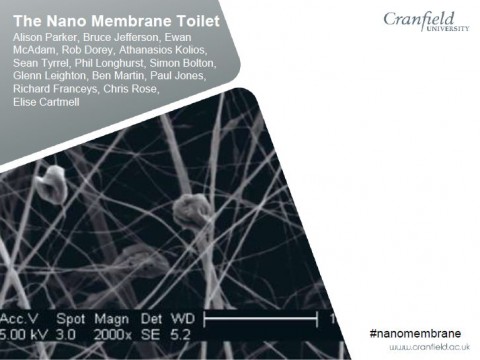This library entry contains background documents for a grant that Alison Parker is leading and which is funded by the WSH Program of the Bill and Melinda Gates Foundation under the Reinvent the Toilet Challenge (RTTC) Round 2.
Further information and a discussion is available on the SuSanA discussion Forum, see link below.
The Reinvented Toilet will accept faeces and urine as a mixed stream. The first stage is to reduce the water content of the sludge through membranes that allow extraction of water as a vapour, using a vacuum pump. This will reduce the sludge to 25% solids. Unlike with conventional membrane separation, the pervaporation process requires only a low vacuum pressure to be applied. The water that crosses the polymer membrane is then condensed on super hydrophilic nanobeads and flows to a distillate store for later use in washing or irrigation.
The remaining sludge will be made into briquettes, which will then be encapsulated in a polymer-nanoparticle fibre using electrohydrodynamic spray atomisation. This will contain the pathogens. The advantage of encasing the sludge with a fibre, compared to an impervious coating, is that water vapour is able to escape from the briquette facilitating further drying. The briquettes could be handled safely and combusted or used as fertiliser. An alternative to using virgin polymer for the coating is to recycle plastic bags. The maintenance of the toilet will require 6 monthly replacements of the membrane cartridge, bead cartridge and polymer. Power for the toilet is generated using a hand crank.
Research components and activities (all carried out at lab-scale in Cranfield):
- Testing of membrane pervaporation for separation of pure water from faeces and urine
- Testing of zeolite nanobeads to condense water and adsorb ammonia
- Development of electrohydrodynamic spray atomisation technology to coat faeces briquettes
- Selection of vacuum pump
- Design of human powered electricity generator
- Overall toilet design, focussing on usability and desirability to get ready for demonstration and field-testing in UK (technology readiness level, TRL 6)
Authors:
Alison Parker, Bruce Jefferson, Ewan
McAdam, Rob Dorey, Athanasios Kolios,
Sean Tyrrel, Phil Longhurst, Simon Bolton,
Glenn Leighton, Ben Martin, Paul Jones,
Richard Franceys, Chris Rose,
Elise Cartmell
+++++++++++++++++++++++++++++++++++++
Available for download below:
1 - Presentation at the Faecal Sludge Management (FSM) 2 Conference in Durban in October 2012
2 - Presentation at Early Career Researchers in Water, Sanitation and Hygiene (ECRWASH) conference held at Cranfield University on 21 November 2013
3 - Presentation about this project at FSM3 Conference in Hanoi, January 2015
Bibliographic information
Parker, A. et al. (2013).
The Nano Membrane Toilet Various documents on results from research grant Cranfield University, UK (and partners)
Filter / Tags
Fundamental research and engineeringEnglish
External links
Further information on discussion forum
Downloads
1 - The Nano Membrane Toilet (presentation, Oct. 2012)
Download
Type: application/pdf
Size: 0.59 MB
2 - Presentation at Early Career Researchers in Water, Sanitation and Hygiene (ECRWASH) conference held at Cranfield University on 21 November 2013
Download
Type: application/pdf
Size: 1.65 MB
3 - Presentation about this project at FSM3 Conference in Hanoi, January 2015
Download
Type: application/pdf
Size: 1.11 MB

Published in: 2013
Pages: 0
Publisher:
Cranfield University, UK (and partners)
Author(s):
Parker, A. et al.
Uploaded by:

